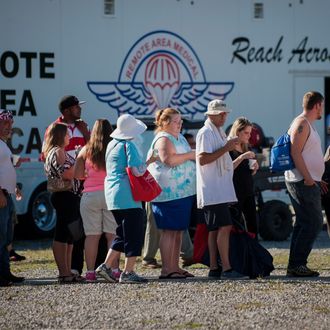
Men at the top of the American income ladder now live 15 years longer than those at the bottom. That gap has grown since the turn of the century, with the top one percent gaining three years in life expectancy since 2001. Over that same period, low-income Americans saw their life expectancy stagnate along with their wages. Today, men in the bottom one percent live about as long as the average man in Sudan.
These are among the most alarming findings in a study published by the Journal of the American Medical Association on the correlation between income and longevity in the United States. But the paper’s most novel discovery is also its most hopeful: Low-income Americans who live in economically diverse urban areas live nearly as long as their middle-class peers.
In New York City, the life expectancy for 40-year-olds with household incomes below $28,000 is 82 years. In the Corpus Christi region of Texas, such Americans can expect to be dead by 77. The poor in Los Angeles, San Francisco, and Birmingham, Alabama, live nearly as long as their wealthy neighbors. Elsewhere, across vast stretches of rural America, the poor are dying even younger than they used to. These findings echo those of a recent Washington Post analysis, which showed a growing gap between health outcomes in urban and rural America.
What makes these studies hopeful is the implication that the life-expectancy gap between rich and poor Americans can be narrowed, even if the income gap continues to widen. To be sure, income inequality remains a threat to our democracy and economic growth, and combating it should be a top priority of public policy. But because the causes of economic inequality are structural and varied — and because the wealthy exert outsize influence over our (dysfunctional) political system — it’s welcome news that poor people in municipalities as unequal as New York City are, nonetheless, living longer.
“You want to think about this problem at a more local level than you might have before,” the study’s lead author, Stanford economist Raj Chetty, told the New York Times. “You don’t want to just think about why things are going badly for the poor in America. You want to think specifically about why they’re going poorly in Tulsa and Detroit,” he said, naming two cities where life expectancy among the poor is especially low.
So why are things going badly in such places? Surprisingly, an area’s unemployment rate had little correlation with the longevity of its poor. Likewise, a region’s rate of Medicare spending wasn’t correlated with longer life spans among low-income residents. Instead, the key correlates for a low life-expectancy gap were high population density, high concentration of college graduates, and high local government spending.
Why such characteristics correlate with better outcomes for the poor is not clear. The primary determinant of life expectancy for all human beings is behavior: People who don’t smoke, eat healthy, and exercise tend to live longer than those who don’t. In an interview with NPR, Chetty speculated that highly educated, high-density cities tend to encourage healthier lifestyles, via smoking bans, or else simply through setting healthier behavioral norms.
There is abundant evidence that unhealthy behaviors proliferate in areas of concentrated poverty. One of the paper’s authors referred to the stretch of rural America where life expectancy among the poor is lowest as the “drug overdose belt,” in an interview with the Times. A map showing where the opioid epidemic has been most concentrated would look roughly identical to one showing where the poor die youngest.
Obviously, combating known threats to public health, like alcohol and opiate addiction, would improve the health outcomes of the poor. But it seems that low-income people are far less susceptible to unhealthy behaviors when they live in areas with more “nanny state” regulations and yuppies toting Whole Foods bags.
In the city and suburbs of Birmingham, Alabama, the life expectancy for adults in the bottom 25 percent rose 3.8 years for men and 2.2 years for women since 2001. Over that same period, the city banned smoking in restaurants and workplaces, while local philanthropies funded health-education campaigns, the Times reports.
The growing disparity between the average life spans of rich and poor Americans underlines the need for drastic action to combat runaway economic inequality. But until such action is taken, urbanization and smoking bans may be the best tools we have for keeping life’s “golden years” from becoming the exclusive property of those with gold in the bank.






























